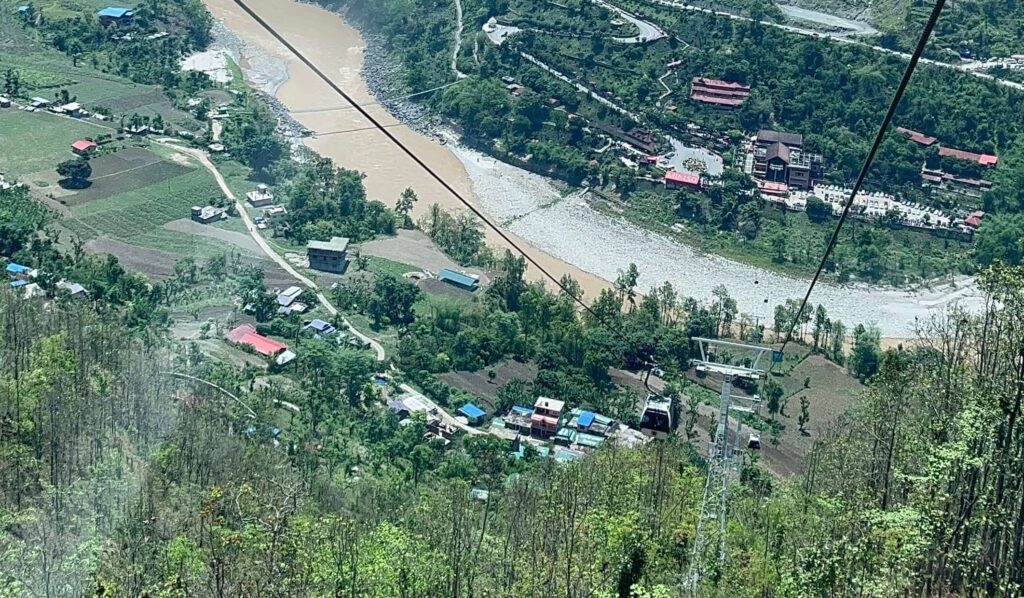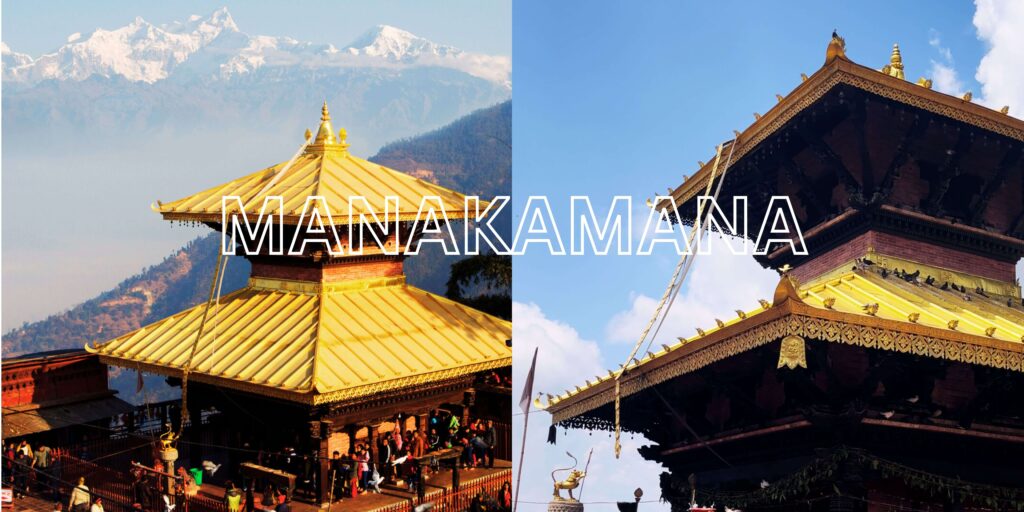In the heart of the Gorkha district in Nepal’s Gandaki province lies a sacred haven known as Manakamana. This temple has been a signal of hope, faith, and miracles for centuries. This enchanting temple, rich in history and Himalayan tales, draws pilgrims and tourists alike.
The name “Manakamana” is derived from two words, “Mana,” meaning heart, and “Kamana,” meaning wish. It’s believed that the deity of this temple has the power to fulfill the wishes of those who visit with a pure heart. Let’s delve deep into the manakamana temple and uncover its mysteries.
History of Manakamana Mandir: Indication of Faith and Reincarnation
The Manakamana history is about strong belief and miracles. Often referred to as the “Wish Fulfilling Deity,” this sacred temple is dedicated to the Hindu Goddess Bhagwati, an embodiment of Parvati.
According to legend, the 17th-century king of Gorkha, Ram Shah’s wife, Queen Lilawati, possessed some supernatural power. She was believed to be a Goddess incarnate. However, her biggest and closest devotee, Lakhan Thapa, solely knew this.
Once, the king accidentally saw his wife as a goddess, and upon revealing this to Thapa later, he passed away immediately. As per the rule, Queen Lilawati committed Sati (death by self-immolation at her husband’s funeral pyre) during her husband’s cremation. To console her bereaved devotee, Thapa, the queen, promised, before her death, that she would appear again near his village.
Around six months after the royal cremation, a local peasant’s plow entangled with a stone while plowing. In the place of the present-day Manakamana temple, blood and milk started flowing from the very stone. The blood and milk flow stopped only after Lakhan worshipped it with his Tantric knowledge.
Subsequently, a temple was built at the same place under the leadership of Lakhan Thapa. Ram Shah’s successive king, Dambar Shah, ordered the late queen’s devotee, Thapa, to look after and worship at the temple. Since then, the rule of choosing a descendent of Lakhan Thapa as a temple priest still exists. The present priest of the Manakamana temple is from Lakhan’s seventeenth generation.
Around the main temple of Manakamana, there are minor temples of over fifteen gods and goddesses. One is Bankeswari temple, where mute and defect children worship; they are believed to have gained their voice and become healthy and stout.
The Manakamana Mandir is more than just its main temple. It is surrounded by over fifteen minor temples dedicated to various deities. Among them is the Bankeswari temple, a beacon of hope for mute and defect children. It is believed that those who worship here are blessed with health, strength, and voice.
The history of the Manakamana Mandir is a tale of faith that has withstood the test of time, of a queen’s promise, and of a deity that continues to bless and inspire. It’s a reminder that legends live on, and faith, once kindled, never truly fades.
Time for Worship at Manakamana Mandir
The Manakamana temple, revered by many, follows a sacred ritual where the temple’s priest performs the initial worship ceremonies twice daily.
Morning ritual commences at: 7 A.M.
Evening ceremony occurs at 6 P.M.
Devotees and visitors can then offer their prayers, perform rituals, and participate in sacrificial activities between these hours. This tradition underscores the importance of the priest’s role in maintaining the temple’s sanctity and ensuring that the divine energies are invoked before the general worship begins.
How to Reach Manakamana Temple?
There are two exciting ways to reach the Manakamana temple, each offering a unique experience.
1. Hiking
A hike is the perfect choice for those who love adventure and nature. Start your journey by crossing a picturesque bridge over the Marshyangdi River in Aanbu Khaireni. As you ascend, immerse yourself in the beauty of the surroundings. After a 3-4 hour hike, you’ll be rewarded with a stunning view of the Manakamana temple.
2. Manakamana Cable Car
If you’re looking for a more relaxed and speedy mode of transportation, the Manakamana cable car is your best bet. Hop on at Kurintar, conveniently located along the Prithvi Highway. As you glide above, enjoy breathtaking aerial views before reaching the temple located in the Gorkha district.
The journey to Manakamana temple promises to be unforgettable, whichever route you choose.

Manakamana Cable Car Operating Time
The Manakamana cable car operating time is as follows:
Opening : 9:00 A.M.
Closing : 5:00 P.M.
Lunch Break : 12:00 P.M. to 1:30 P.M.
Manakamana Cable Car Ticket Price
The cable car manakamana price varies for locals and tourists. While locals can benefit from a discounted rate, tourists are charged a standard fee. The different categories and their price rates are listed:
Category
Adult (Nepali)
Child (Nepali)
Student (Nepali)
Senior Citizen (Nepali)
Differently Abled
Adult (Indian)
Child (Indian)
SAARC & Chinese
SAARC & Chinese Child
Foreigner
Child (Foreigner)
Sacrificial Goat
Goods
One Way Price
NRs. 450.00
NRs. 270.00
NRs. 335.00
NRs. 315.00
NRs. 225.00
INR. 400.00
INR. 240.00
US$ 6.00
US$ 4.00
US$ 11.00
US$ 8.00
NRs. 275.00
NRs. 20.00/KG
Two Way Price
NRs. 770.00
NRs. 460.00
NRs. 575.00
NRs. 540.00
NRs. 385.00
INR. 670.00
INR. 400.00
US$ 10.00
US$ 7.00
US$ 20.00
US$ 15.00
–
–
- Children are classified based on their height, with those above 3 feet and up to 4 feet tall eligible for a child ticket.
- Individuals aged 60 years and above qualify for a senior citizen ticket.
- Proof of identification or an ID card is required for senior citizen and student tickets.
- Passengers are allowed free baggage weighing up to 15 kg; however, excess baggage will incur a charge of NRs. 20 per kilogram.
Location, Altitude, and Distance of Manakamana Mandir
Manakamana temple, located in the Gorkha district of Nepal, is a significant pilgrimage site for Hindus worldwide. It is 12 kilometers south of Gorkha town, on a hilltop at an altitude of 1,302 meters (4,300 feet) above sea level, overlooking the Trishuli River valley in the south and Marsyangdi in the west.
The journey to Manakamana temple is an experience in itself. The distance from Kathmandu to Manakamana is approximately 140 kilometers. It takes about 5-6 hours of driving or approximately two hours by cable car to reach the temple from Kathmandu. Similarly, the distance between Pokhara and Manakamana is 203.3 kilometers, which also takes approximately 5-6 hours of driving.
Visiting the Manakamana temple is a spiritual journey and an opportunity to witness the breathtaking beauty of the Nepalese landscape. The temple, surrounded by lush green hills, offers a panoramic view of the river valleys below and the snow-capped mountains in the distance. It is a place of serenity, spirituality, and natural beauty, making it a must-visit destination for anyone traveling to Nepal.
Book your Manakamana Mandir Tour with Best Travel Agency
Manakamana Temple with Holiday Pasal – book now for an enriching and no hassle pilgrimage experience!
Frequently Asked Questions
Who Invented Manakamana Temple?
Lakhan Thapa, the devotee of the queen of Gorkha King Ram Shah, built the temple of Manakamana Devi.
Who is the Priest at Manakamana Temple?
The priest at Manakamana Temple is a descendant of Lakhan Thapa. The current priest at the temple is the 17th generation descendant of Lakhan Thapa.
How Many Cable Cars Are There in Manakamana?
There are 34 boxes. Among them, 31 are for the passengers and 3 for the cargo. Each car has six people’s capacity to carry one at a time.
What Is the Architecture of Manakamana Temple?
The temple of Manakamana Devi is a small, two-storeyed pagoda-style temple. The roof is made of copper, and the walls are stone. The temple is dedicated to the goddess Manakamana Devi, who is believed to fulfill the wishes of her devotees.
Which Mountains Are Seen From Manakamana Temple?
The temple’s elevated location offers panoramic views of the surrounding mountains. To the north, excellent views of the Manaslu, Himalchuli, and Annapurna mountains can be seen.
What Time Does Manakamana Cable Car Break?
The cable car usually takes a break from 12 P.M. to 1:30 P.M. It’s advisable to plan your trip accordingly.





